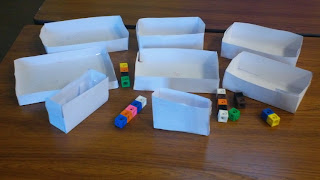I often find that y10 and y11 lessons fall foul of time pressure. There is so much content to cover, in such a limited amount of time, that there doesn't seem to be much room for creativity. In y7, y8 and y9 I'm always keen to make lessons as creative as possible but with the older year groups the prospect of exams always seems to loom large and we don't get to have as much fun.

I usually plan y10 lessons with a colleague of mine who teaches a similar, middle ability group and I always find it really useful to talk to her. Two brains are definitely better than one! When we saw volume on the scheme of work, we both agreed that we'd like to get some practical activities involved, and this is what we came up with.
In the first lesson we gave the students some nets and asked them to work out the surface area. We took the opportunity to recap how to work out the area of simple shapes (rectangles, triangles, circles) and some of them took on the challenge of working out more complex shapes (trapeziums, pentagons, hexagons).
In the next lesson they cut out and made the nets into 3D shapes. We then talked about classifying the 3D shapes and they got into the idea of prisms. Not content with the shapes they had made, the girls wanted to look for prisms in the rest of the room. Surprise surprise, there were quite a few dotted around the place (it's not like I was collecting examples or anything) including a lovely octagonal quality street tin that just happened to be sitting at the front.
It was a really worthwhile lesson, although I'm pretty sure the pace would have been considered too slow by Ofsted. It took a while to cut and stick all the shapes, but once they had made them, the girls clearly understood how all the faces fitted together and they had no problems appreicating that the volume of a prism was cross-sectional area x length.
We had another lesson on calculating the volume of more complex prisms including problems where they were given the volume and hade to work out a missing length or area. Then in today's lesson we looked at the cuboid challenge where you give students a single piece of paper and ask them to make an open-topped box with the greatest possible volume. I think this task is usually done as a nice introduction to calculus, or at least plotting the graph of a cubic equation (nrich, as always, have explanations of how it works if you're not sure http://nrich.maths.org/6399/solution ). But, much as I feel a bit pained to say it, I wasn't bothered about the algebra this time. I wanted students to get a feel for dimensions and to have a go at a practical version of trial and improvement. I also wanted to make a big deal of the second part of the challenge, where I gave them 4 multi-link cubes each and asked them to work out how many whole cubes they could fit in their boxes.

The picture above shows the efforts of the winning team of 4 students, and the photo on the right shows a section of working out in another student's book. I asked the girls to work out the volume of every box made by their team and only once they had finished that were they allowed some cubes so they could work out how many cubes would fit inside. At first they were unimpressed with the quota of 4 cubes each, but they quickly figured out what to do and even the weakest students in the class seemed pretty motivated.
There is much more you could explore with volume, but I feel pleased that even in a limited time we managed to cover a lot of content in a way that didn't feel pressured and allowed the students time to become really familiar with 3D shapes. I'm sure that making the shapes, physically measuring them and turning them round in their hands helped the girls to understand what they were doing far more than simply working from a textbook would have done.

No comments:
Post a Comment